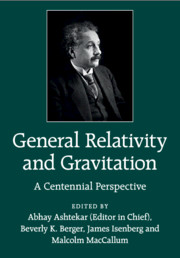Book contents
- Frontmatter
- Contents
- Preface
- List of contributors
- List of figures
- List of tables
- Part One Einstein's Triumph
- 1 100 Years of General Relativity
- 2 Was Einstein Right? A Centenary Assessment
- 3 Relativistic Astrophysics
- 4 Cosmology
- Part Two New Window on the Universe: Gravitational Waves
- Part Three Gravity is Geometry, after all
- Part Four Beyond Einstein
- Index
- References
4 - Cosmology
from Part One - Einstein's Triumph
Published online by Cambridge University Press: 05 June 2015
- Frontmatter
- Contents
- Preface
- List of contributors
- List of figures
- List of tables
- Part One Einstein's Triumph
- 1 100 Years of General Relativity
- 2 Was Einstein Right? A Centenary Assessment
- 3 Relativistic Astrophysics
- 4 Cosmology
- Part Two New Window on the Universe: Gravitational Waves
- Part Three Gravity is Geometry, after all
- Part Four Beyond Einstein
- Index
- References
Summary
Introduction
David Wands and Roy Maartens
Our Universe provides the grandest arena in which to test General Relativity as a theory of space, time and gravity. It becomes essential to consider both the causal propagation of matter and radiation through space-time and the dynamical evolution of space-time if we are to construct a consistent theoretical framework in which to interpret astronomical observations on the largest observable scales. Einstein himself originally tried to construct a static cosmology but it was soon appreciated that the field equations of General Relativity naturally accommodate dynamical and evolving space-times. Einstein's own static model of a 3-sphere, balancing the gravitational pull of matter against a positive spatial curvature and a cosmological constant was shown to be poised between expansion and collapse and hence unstable to infinitesimal disturbance.
Friedmann and Lemaître showed that Einstein's field equations admit expanding- universe solutions, which have become the basis for modern cosmology, despite Einstein's initial dismissal of the solutions. However persuasive the theoretical models, empirical observations are, of course, necessary to determine the actual dynamics of our observable Universe; the work of Slipher and Hubble in the 1920s [1] persuaded scientists that in fact our Universe is expanding. The logical consequence of this expansion is that either our Universe was hotter and denser in the past (coming ultimately from a Hot Big Bang) or, perhaps, that energy had to be continually created as the universe expanded (the Steady State model). The discovery of the Cosmic Microwave Background (CMB) radiation by Penzias and Wilson in 1965 [2] convinced most astronomers that the Universe did in fact begin at a Hot Big Bang, a finite time in the past. This hot dense plasma, in thermal equilibrium at early times, also provides a setting for the freezing out of the light atomic nuclei as the universe cools below several million degrees Kelvin [3], although heavier elements must be formed later in stars.
- Type
- Chapter
- Information
- General Relativity and GravitationA Centennial Perspective, pp. 162 - 232Publisher: Cambridge University PressPrint publication year: 2015

